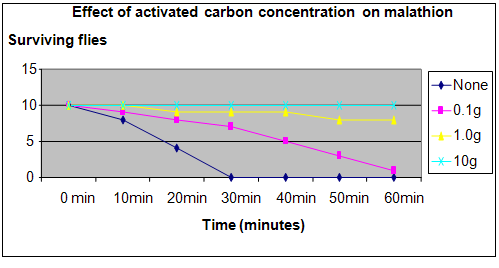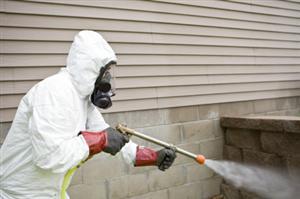| Complexity level: | 8 |
| Project cost ($): | 40 |
| Time required: | 1 hour to prepare, 1 hour for the science project experiment |
| Material availability: | You will need to trap 40 houseflies for this experiment. |
| Safety concerns: | Ensure that safety masks, goggles and gloves are worn at all times when handling the Malathion and the flies. Malathion is extremely toxic and should be handled properly, in a controlled laboratory under the supervision of your science teacher. |
Hypothesis
A higher concentration of activated carbon will neutralize the pesticide malathion and flies will be able to survive, even though they are exposed to the pesticide.
Overview
Activated carbon
Activated carbon is an extremely porous carbon that has a very large surface area. A single gram of activated carbon has over 500 square millimeters of surface area. The large surface area is made available for the carbon to absorb and react with other chemicals. Activated carbon is also known as activated charcoal. It is usually made from charcoal. Activated carbon is very useful in the removal of pollutants from water and air. They are used in air purification, water filtration, cleaning spills and remediation of ground water. Activated carbon is also used in the treatment of poisoning and overdose from oral medication.
Malathion pesticide
Malathion is a common agricultural pesticide. It is used in farms, recreational areas, residential landscape and public parks. Malathion is found to be useful in pest control applications and is used to eradicate flies and mosquitoes. Malathion is normally mixed with diesel fuel and used to fog areas that are known to be infested with mosquitoes and other pests. Malathion is also used in low doses for treating body and head lice.
Scientific Terms
Materials
The materials required for this science fair project:
- 40 flies
- Plastic bags
- 4 over-ripe bananas
- 1 digital weighing scale
- 1 measuring cylinder
- 1 bottle of distilled water
- 1 bottle of activated carbon
- 1 can of malathion pesticide spray
- 4 empty aquarium tanks with top cover
- 1 knife
- 3 spray containers
Procedure
1. For this science fair project, the independent variable is the concentration of activated carbon solution – 0.1gram/100ml, 1.0gram/100ml or 10gram/100ml. The dependent variable is the number of flies still alive in each aquarium at the end of the 1-hour period. This is determined by observing the number for flies still alive every 10 minutes. The constants (control variables) are the over-ripe banana, the size of the fish tank used for the experiment, and the concentration of the Malathion spray.
2. Forty flies are caught in plastic bags (not a very pleasant experience, but you can try catching them at garbage dumps) or by attracting them with rotting food.
3. The 3 spray containers are labeled A, B and C. Using the digital weighing scale, 0.1mg of activated carbon is added to container A, 1.0mg in container B and 10mg in container C. 100ml of distilled water is added to all the 3 containers. The solution in each container is stirred/mixed before the container is resealed with its spray nozzle-top.
4. The 4 aquariums are labeled as A, B, C and D. Overripe bananas are cut in half and the exposed area is sprayed with malathion spray. One of the bananas is placed in the aquarium marked as D. The liquid in container A is sprayed over the exposed surface of one of the bananas which is then placed in the aquarium marked A. Similarly, sprays B and C are sprayed over the other bananas and then placed in aquariums B and C.
5. Ten flies are released into each of the 4 aquariums. The number of flies still alive is observed every 10 minutes and recorded in the table given below.

Results
The results showed that using a higher concentration of activated carbon increased the survival rate of the flies.
|
Malathion concentration |
Number of flies surviving |
||||||
|
0 min |
10min |
20min |
30min |
40min |
50min |
60min |
|
|
None |
10 |
8 |
4 |
0 |
0 |
0 |
0 |
|
0.1g/100ml |
10 |
9 |
8 |
7 |
5 |
3 |
1 |
|
1.0g/100ml |
10 |
10 |
9 |
9 |
9 |
8 |
8 |
|
10g/100ml |
10 |
10 |
10 |
10 |
10 |
10 |
10 |
The graph/chart below represents the result of our science project experiment.

Conclusion
Our hypothesis has been proven correct. A higher concentration of activated carbon will neutralize the pesticide malathion and flies will be able to survive, even though they are exposed to the pesticide.
Activated carbon is very useful for cleaning up pesticide spills and to mop up excess pesticides on agricultural farms. Once the pesticide has been absorbed by the activated carbon, it effectively becomes harmless.
Also consider
The results of our science project experiment would perhaps be more reliable/meaningful, if we were to use a larger number of flies or a larger number of pesticide concentrations. Try repeating the experiment using different types of insects like mosquitoes or cockroaches.
Also try repeating the science experiment by comparing the effectiveness of activated carbon in neutralizing other types of pesticides.
References
Malathion - http://en.wikipedia.org/wiki/Malathion
Activated carbon - http://en.wikipedia.org/wiki/Activated_carbon
Using activated charcoal to inactivate agricultural chemical spills - http://www.bae.ncsu.edu/programs/extension/publicat/wqwm/ag442.html

